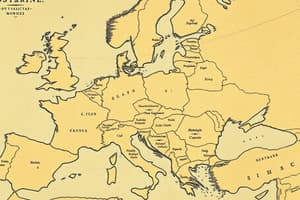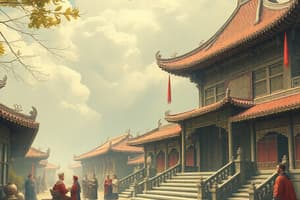Podcast
Questions and Answers
What was one of the main purposes of Zheng He's maritime expeditions?
What was one of the main purposes of Zheng He's maritime expeditions?
- To expand Chinese trade and diplomacy across different regions. (correct)
- To establish military bases in other countries.
- To mine for valuable resources in foreign lands.
- To search for new territories to conquer.
During which Chinese dynasties did the development of porcelain significantly impact the global ceramics industry?
During which Chinese dynasties did the development of porcelain significantly impact the global ceramics industry?
- Ming and Qing Dynasties
- Sui and Yuan Dynasties
- Han and Qin Dynasties
- Tang and Song Dynasties (correct)
What was the key characteristic of porcelain that made it ideal for tea wares?
What was the key characteristic of porcelain that made it ideal for tea wares?
- Brittleness
- Opaque appearance
- Low water absorption (correct)
- High cost of production
Which of the following accurately describes the impact of Zheng He's voyages on trade and diplomacy?
Which of the following accurately describes the impact of Zheng He's voyages on trade and diplomacy?
What was the major impact of the development of rice terraces during the Han Dynasty in China?
What was the major impact of the development of rice terraces during the Han Dynasty in China?
Which Chinese invention revolutionized warfare, manufacturing, and art during medieval times?
Which Chinese invention revolutionized warfare, manufacturing, and art during medieval times?
What was the primary significance of silk production in ancient China?
What was the primary significance of silk production in ancient China?
Which religious belief became a dominant force in Chinese spirituality during the medieval period?
Which religious belief became a dominant force in Chinese spirituality during the medieval period?
What was a prelude to Europe's Age of Exploration as mentioned in the text?
What was a prelude to Europe's Age of Exploration as mentioned in the text?
Which Chinese engineering marvel from ancient times is still admired today for its agricultural significance?
Which Chinese engineering marvel from ancient times is still admired today for its agricultural significance?
Flashcards are hidden until you start studying
Study Notes
Middle Ages in China: An Exploration of Zheng He, Porcelain, Terraced Rice Fields, and More
Medieval China was a tapestry of cultures, innovations, and exchanges that would shape the world for centuries to come. In this article, we'll dive into the remarkable figures, traditions, and inventions that originated during this era and continue to inspire us today.
Zheng He and the Silk Roads
Zheng He (1371-1435) was a eunuch admiral under the Ming Dynasty known for his seven epic voyages across the Indian Ocean, Red Sea, and Persian Gulf. Zheng He's maritime expeditions, which began in the early 15th century, expanded Chinese trade and diplomacy across a vast network of routes that rivaled the Silk Road. These journeys connected China with lands as far-flung as Southeast Asia, India, and Africa, fostering understanding and trade among diverse peoples.
Porcelain: China's Timeless Gift to the World
Porcelain, the translucent, strong, and lustrous ceramic, originated in medieval China and is one of its most enduring legacies. This material's development during the Tang and Song Dynasties revolutionized the global ceramics industry. Porcelain's hardness, strength, and low water absorption made it ideal for tea wares, and the artistry of its designs, such as the delicate blue and white patterns, continues to captivate collectors and enthusiasts to this day.
Terraced Rice Fields: China's Feast for the Eyes
In the mountains of southern China, rice terraces were painstakingly constructed, creating a spectacle of agriculture that is still admired today. These engineering marvels, first developed during the Han Dynasty, allowed farmers to cultivate rice in regions with sloping terrain, turning what might have been barren hillsides into verdant landscapes that feed China and offer picturesque vistas for travelers.
Exploding Powder: A Chinese Scientific Breakthrough
Medieval Chinese scientists developed gunpowder, a mixture of saltpeter, charcoal, and sulfur. This invention, believed to have occurred in the 8th or 9th century, transformed warfare, manufacturing, and art. Gunpowder's ability to explode with a flash of light and a deafening report gave rise to fireworks, firearms, and even the rocket, which was initially used for fireworks before becoming a military and space technology.
Silk: China's Timeless Thread
Silk, the luxurious fabric produced from silkworms' cocoons, has been a symbol of wealth and sophistication since its inception in China over 5,000 years ago. Silk production was a highly-guarded secret for centuries, with Chinese emperors controlling its production and trade under strict penalties. The Silk Road was instrumental in spreading this elegant fiber across the continent and beyond, becoming an emblem of globalization long before the term existed.
Buddhism, Islam, and Daoism: The Spirit of Medieval China
Medieval China was home to a vibrant religious landscape that included Buddhism, Islam, and Daoism. Buddhism, introduced from India during the Han Dynasty, became a dominant force in Chinese spirituality, with its influence evident in architecture, sculpture, and calligraphy. Islamic trade with China, which began in the 7th century, contributed to the spread of Islam throughout the region, while Daoism, a native Chinese philosophy, has maintained a steady presence throughout history, exerting a profound influence on Chinese arts, literature, and thought.
Traveling Europe During the Age of Exploration
As China flourished during the Middle Ages, Europe was beginning its own Age of Exploration. The story of Zheng He's maritime expeditions, along with the Silk Road's enduring influence, is a prelude to Europe's quest for global trade, resources, and the spread of Christianity. Despite the differences in time and geography, the connections between these two seemingly disparate eras continue to fascinate scholars and history enthusiasts alike.
This brief exploration of medieval China's Zheng He, porcelain, terraced rice fields, exploding powder, and silk, along with its religious and cultural traditions, reveals a complex and dynamic era in human history. The legacy of these remarkable innovations and endeavors continues to captivate the world today, inspiring us to cherish the rich tapestry of the human experience and emboldening us to explore the possibilities of the future.
Studying That Suits You
Use AI to generate personalized quizzes and flashcards to suit your learning preferences.




